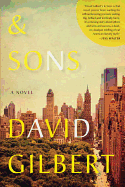
David Gilbert's novel & Sons explores the existential tension between literary fame and family legacy for A.N. Dyer, an elderly writer whose double-initial moniker and early success are reminiscent of J.D. Salinger's, but whose seclusion is provided by a doorman-guarded duplex with views of Central Park rather than a house in the New Hampshire woods. Now in poor health, 79-year-old Dyer has mounted a late campaign to connect his semi-estranged adult sons Richard and Jamie with their half-brother Andy, the extramarital progeny whose surprise existence impelled their mother to divorce Dyer 17 years earlier. As the title promises, & Sons is as much about the exploits of this second-and-a-half generation as the preoccupations of its pater.
Several sleights of narrative advance & Sons beyond dysfunctional prepster family realism. Gilbert (The Normals; Remote Feed) filters the story through Philip Topping, the son of A.N.'s recently deceased childhood buddy and a Dyer-son wannabe from way back. Topping's omniscient perspective on the Dyers and their interior lives, permeated with covetousness and bile yet occasionally pathetic, creates a fluctuating schism in the reader's sympathies. Gilbert also embeds clue-filled excerpts from Dyer's megaselling novel Ampersand and scatters a trail of facsimile correspondence and sly literary references. Most daringly, the novel's biggest narrative mischief reveals itself at the halfway point, when a seminal plot point reconfigures & Sons both backward and forward.
Gilbert's & Sons is the kind of book that generates that magic reading tension between impatience to know what happens next and the desire to prolong immersion as long as possible. --Holloway McCandless, blogger at Litagogo: A Guide to Free Literary Podcasts

